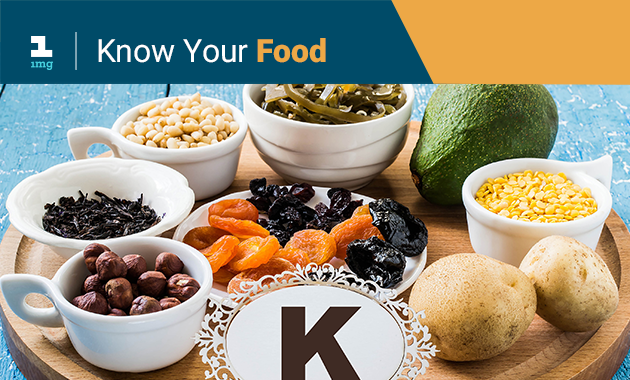
Potassium is an essential mineral needed for the proper functioning of the heart and bones. But thanks to the Western diets and the intake of processed foods rich in sodium, there is a decreased intake of potassium from fruits and vegetables. The lack of this mineral can lead to various health problems such as cardiac arrhythmias, muscle weakness, paralysis and intestinal problems. Moreover, potassium is important for people suffering from high blood pressure as it can help to reduce the risk of heart complications and stroke.
Recommended Dietary Allowance (RDA) of potassium
According to the National Institute of Nutrition (NIN), the daily recommended dose of potassium varies with age. Here are the values for infants, kids, and adults.
Infants and children
0-6 months: 350 – 925 mg
6-12 months: 475 – 1275 mg
1-3 years: 550 – 1650 mg
4-6 years: 775 – 2325 mg
Adults
Men: 3750 mg
Women: 3225 mg
Food sources of potassium
As the body cannot produce this mineral, you have to include foods rich in this mineral in diet. Hence, it is important to include foods rich in this mineral in the diet without fail. Here are common foods sources of potassium.
All values are taken from the National Institute of Nutrition (NIN)’s Indian Food Composition Tables 2017 and are expressed per 100 gms of edible portion*
Cereals and millets
-Ragi: 443 mg
-Amaranth seeds, black: 433 mg
-Wheat, bulgur: 330 mg
-Jowar: 328 mg
Grains/legumes
-Soya bean: 1613 mg
-Rajma: 1324 mg
-Cowpea: 1241 mg
-Green gram: 1177 mg
-Black gram, dal: 1157 mg
-Horse gram: 1065 mg
-Bengal gram: 935 mg
Green leafy vegetables
-Agathi leaves: 674 mg
-Spinach: 625 mg
-Amaranth leaves: 572 mg
-Tamarind leaves, tender: 465 mg
-Mustard leaves: 403 mg
-Drumstick leaves: 397 mg
-Cabbage: 233 mg
-Fenugreek leaves: 226 mg
Other vegetables
-Drumstick: 419 mg
-Plantain, green: 402 mg
-Ash gourd: 372 mg
-Broad beans: 362 mg
-Cauliflower: 329 mg
-Jackfruit, raw: 327 mg
-Bitter gourd: 326 mg
-French beans: 324 mg
-Baby corn: 260 mg
Fruits
-Bael fruit: 409
-Avocado: 377
-Banana: 362
-Wood apple: 347 mg
-Guava, white flesh: 283 mg
Roots and tubers
-Lotus root: 611 mg
-Potato: 541 mg
-Colocasia: 514 mg
-Yam: 463 mg
-Water chestnut: 382 mg
Condiments and spices
-Turmeric powder: 2374 mg
-Chilies, red: 2245 mg
-Cumin seeds: 1886 mg
-Black pepper: 1487 mg
-Curry leaves: 584 mg
-Coriander leaves: 546 mg
-Garlic: 453 mg
Nuts/ dry fruits
-Raisins, dried, black: 1105 mg
-Pistachios: 1053 mg
-Dates: 804 mg
-Almonds: 699 mg
-Groundnut: 679 mg
* All the values are approximate values of the food sources
Recommended Reads:
10 Tips To Get Accurate Blood Pressure Readings At Home
5 Ways To Prevent Heart Diseases
References:
Indian Food Composition Tables 2017. National Institute of Nutrition (indian Council of Medical Research)